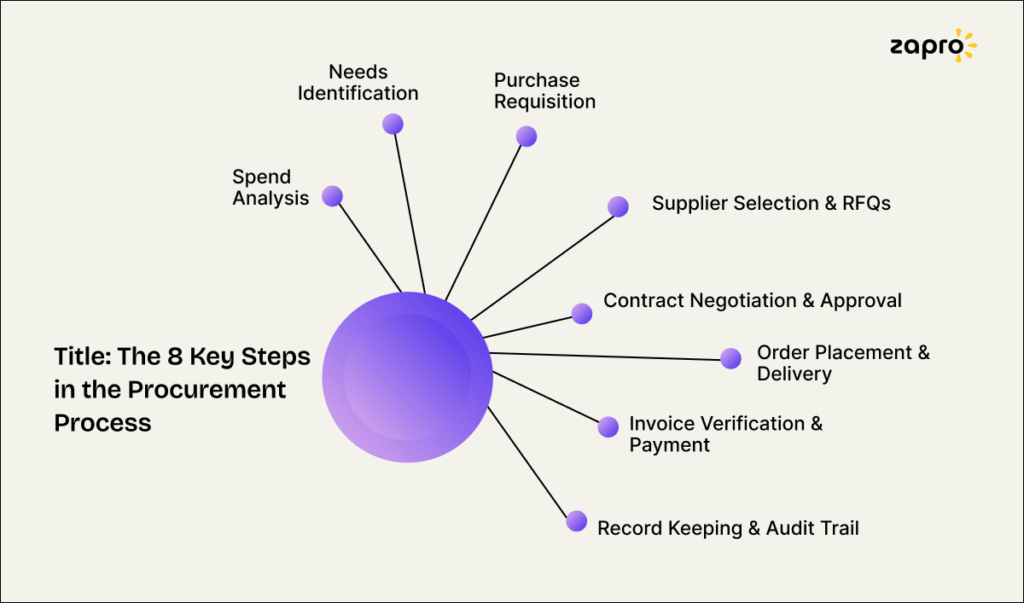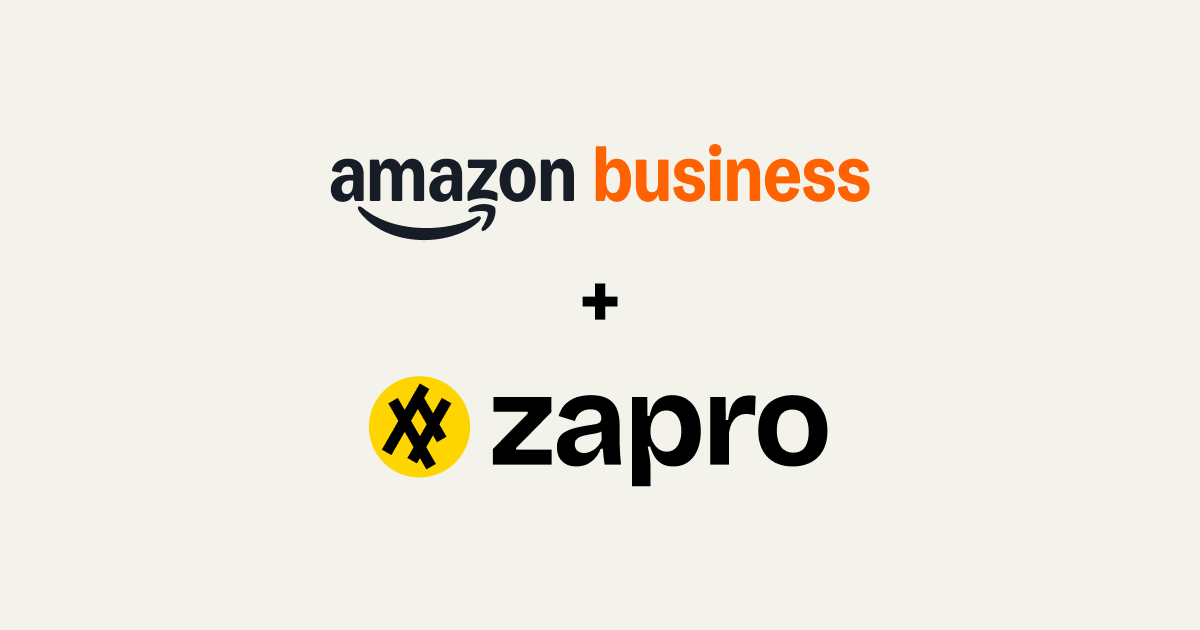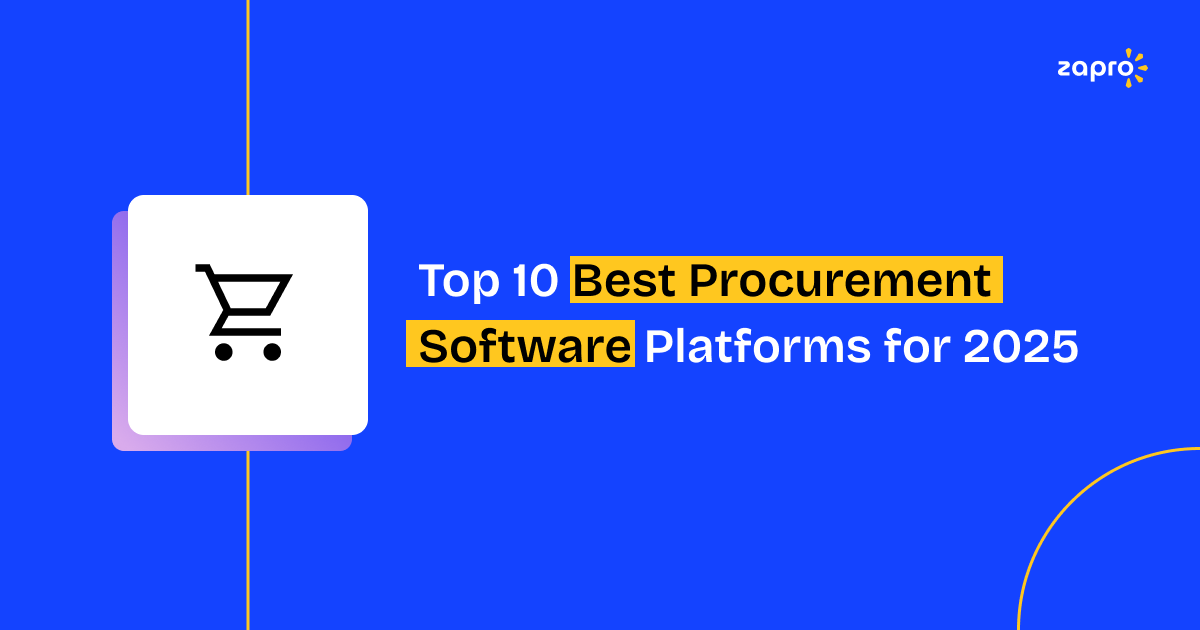Let’s face it slow approvals, invoice mismatches, and missed early-payment discounts quickly drain time and money. Manual workflows only make it worse, slowing teams down and increasing errors.
But when procurement runs smoothly, it can cut cycle times by 75%, improve spend control, and prevent off-contract purchases.
In this quick guide, we’ll break down the 7 key steps of the procurement process so you can streamline operations, reduce risk, and strengthen supplier relationships in 2025 and beyond.
What is Procurement?
Businesses use procurement to acquire necessary goods and services which enable their operational success. The procurement process extends beyond simple buying because it requires supplier assessment and contract settlement and cost reduction and delivery schedule maintenance. Businesses in the present day prioritize sustainability alongside risk management and long-term supplier partnership development as part of their procurement operations. Organizations today implement procurement process management software and e procurement process platforms to enhance their workflows and achieve better visibility and maintain regulatory compliance.
What Is the Procurement in Business and Why It Matters
Procurement in business is the strategic process of sourcing and acquiring goods and services to meet operational and long-term goals. Unlike basic purchasing, procurement involves a full-cycle approach from identifying business needs and evaluating suppliers to negotiating contracts and managing ongoing supplier relationships.
It’s more than placing orders. Procurement involves identifying needs, evaluating suppliers, negotiating terms, and managing vendor relationships over time.
Whether you’re using spreadsheets or a full-scale e-procurement software, the goal is the same: reduce costs, improve efficiency, and deliver value across the business.
Here’s why procurement matters: it can influence up to 80% of a company’s total costs. That means how well your procurement team performs has a direct impact on your bottom line.
A strong procurement process supports the business by:
- Strengthening supplier relationships using vendor management systems
- Cutting long-term costs through better control of the procurement life cycle
- Improving quality and service delivery
- Navigating procurement challenges more effectively
- Staying aligned with company goals and tracking progress through procurement KPIs
With the right mix of procurement solutions, organizations gain better visibility into spending, forecast more accurately, and bridge the gap between procurement and finance. Combine that with modern procurement tools and supplier management software, and procurement evolves from a back-office function to a strategic engine for growth.
What’s the difference between indirect, direct, and services procurement?
Understanding the different types of procurement allows organizations to tailor their strategies and maximize value across all areas.
| Type of Procurement | Description | Example |
| Direct Procurement | Involves buying goods and materials that directly impact the company’s core products or services. It affects production and revenue directly. | A car manufacturer buying steel, tires, and engines. |
| Indirect Procurement | Refers to goods and services that support daily operations but don’t go into the final product. These purchases impact efficiency rather than production. | Office supplies, marketing services, or IT software. |
| Services Procurement | Focuses on acquiring people-based or professional services needed for business operations or projects. | Hiring consultants, maintenance contractors, or logistics providers. |
This classification helps procurement teams manage different spending categories more effectively and apply the right strategies for cost control and efficiency.

By 2026, generative AI will deliver at least a 12% reduction in procurement costs and an 11% increase in revenue for organizations that adopt it effectively.
Why Procurement Matters
Each type of procurement needs its own approach. Direct procurement drives production, while indirect and services procurement keep operations running smoothly. Mastering them strengthens the whole procurement life cycle and supports your business goals.
What is a Procurement Process?
Organizations use the procurement process as a systematic workflow to determine their needs before choosing suppliers and establishing purchase terms and making acquisitions and handling contracts. In simple terms, it answers the question: “what is the procurement process and how does it work?”
The standard procurement process includes need identification followed by supplier evaluation and purchase order generation and goods or service receipt and invoice payment. The increasing complexity of worldwide supply chains has led organizations to implement e procurement process solutions and digital tools which standardize operations while providing transparency and minimizing human mistakes. Businesses achieve competitive advantage through continuous procurement process improvement because it enables them to decrease costs while minimizing risks and improving their relationships with suppliers.
Steps involved in a Procurement Process

Mastering the procure-to-pay process helps organizations control spending, boost efficiency, and strengthen supplier relationships.
Here’s a detailed look at each essential step visualized as a smooth, interconnected workflow.
1. Spend Analysis
Procurement success starts with a thorough spend analysis. This data-driven step cleans and classifies past expenditure data to identify savings opportunities and improve sourcing strategies. By reviewing procurement KPIs and supplier performance metrics, you gain insight into spending patterns and potential cost reductions.
2. Needs Identification
Someone in the organization must recognize a need for goods or services to trigger procurement. This step involves verifying if regulations like the State Purchasing Act apply, analyzing existing supplier options, and deciding if competitive bidding is required. Collaboration across departments is crucial to align procurement with actual business needs.
3. Purchase Requisition
Once needs are identified, a purchase requisition is created a formal internal request outlining the product/service details. This document includes key info: requester, department, quantities, prices, business justification, and suggested vendors. It moves through approval channels, usually involving line managers and procurement teams.
4. Supplier Selection and RFQs
Approved requisitions lead to supplier selection. Your team evaluates vendors based on criteria such as quality, reliability, and cost.
Requests for Quotations (RFQs) or Proposals (RFPs) are sent to gather competitive bids. This process may include supplier audits or site visits to ensure credibility and compliance.
5. Contract Negotiation and Approval
Negotiation shapes contract terms price, delivery, quality, payment, and more. The goal is a win-win relationship that balances fair pricing with supplier partnership longevity.
A well-negotiated contract reduces risks and ensures performance expectations are clearly set.
6. Order Placement and Delivery
With contracts approved, purchase orders are issued, confirming quantities, prices, delivery terms, and any special instructions. This formalizes the purchase and creates a legal record.
Upon delivery, goods/services are inspected for accuracy, quality, and damage to prevent discrepancies.
7. Invoice Verification and Payment
Before payment, invoices undergo a three-way match against the purchase order and receiving report to ensure consistency. This control prevents overpayment or fraud.
Once verified, invoices are processed for payment within agreed terms, maintaining supplier trust and financial discipline.
8. Record Keeping and Audit Trail
Maintaining thorough documentation of all procurement activities creates transparency, accountability, and compliance. These records support audits, help resolve disputes, and provide valuable data for continuous procurement improvements. Strong record keeping strengthens the entire procure-to-pay process.
Mastering these steps with support from procurement software and procurement tools helps your organization reduce cycle times, control costs, and build strategic supplier partnerships.
Common Procurement Challenges to Watch For
Procurement leaders face many hurdles in making their processes efficient and strategic.
According to a recent Deloitte survey:
- 76% of procurement leaders rank digital transformation as a top priority, yet only 32% have fully implemented their digital strategy.
- 70% of Chief Procurement Officers (CPOs) reported increased procurement risks over the past year.
Key Challenges Include:
- Fragmented Supplier Base
Managing multiple suppliers without integration leads to complexity, inconsistent quality, and missed opportunities for volume discounts. - Poor Spend Visibility
Without clear insights into where money is going, organizations struggle to control costs and optimize sourcing decisions. - Maverick Purchasing
Unapproved buying outside of contracts causes budget leaks and compliance risks. - Manual Processes
Paper-based and siloed workflows slow down procurement cycles, increase errors, and reduce overall efficiency. - Compliance Issues
Adhering to regulatory requirements and internal policies is harder without automated checks and audit trails. - Limited Strategic Focus
Many procurement teams remain transactional rather than becoming strategic partners who drive value and innovation.
Additional Challenges to Consider:
- Supply Chain Disruptions
Global events and market volatility create unpredictable delays and shortages. - Data Security & Privacy Risks
Managing supplier and transaction data securely is critical as cyber threats rise. - Sustainability & Ethical Sourcing Demands
Increasing pressure to meet environmental and social governance (ESG) standards adds complexity to supplier evaluation. - Stakeholder Alignment
Misalignment between procurement, finance, and operations can stall decision-making and slow approvals.
Tackling these challenges requires a mix of smart technology like e-procurement software and vendor management systems plus clear policies, skilled teams, and continuous process improvement.
How to Optimize Your Procurement Processes
Optimizing procurement isn’t just about cutting costs it’s about making your entire purchasing operation smarter, faster, and more strategic.
Here’s how organizations can enhance their procurement processes for maximum impact:
Automate Repetitive Tasks
Manual work slows teams down and leads to costly errors. Automating order processing, invoice approvals, and workflows speeds up cycle times and improves accuracy. Studies show automation can onboard suppliers 10x faster, reduce requisition-to-order costs by 48%, and cut transaction cycles in half. Using e-procurement software gives your team real-time data to make smarter pricing and sourcing decisions.
Centralize Procurement Operations
Centralizing procurement unlocks your organization’s buying power. It helps negotiate better deals, enforce consistent standards on quality and pricing, and reduce costs. Centralized systems create rich datasets for strategic decisions, while a “center-led” model balances flexibility with governance and risk control.
Conduct Regular Spend Analysis
Spend analysis is the backbone of optimization. By collecting, cleansing, and categorizing expense data, procurement managers gain a clear view of where money goes. This helps uncover savings opportunities companies often save 3-5% of spend through structured, recurring analysis. Regular spend reviews support smarter sourcing and budget planning.
Implement Strategic Sourcing Practices
Strategic sourcing moves procurement beyond simple buying into a value-driving function. It involves continuously evaluating suppliers, scoring bids systematically, and aligning sourcing with business goals. This reduces risks, boosts supplier performance, and improves cost-efficiency over time.
Monitor Supplier Performance
Supplier management is key to maintaining quality and controlling costs. Track delivery accuracy, product quality, warranty claims, and service responsiveness. Use both quantitative KPIs and stakeholder feedback for a complete view. Regular supplier reviews help reduce supplier count while raising quality often unlocking cost savings and stronger partnerships.
Foster Cross-Department Collaboration
Successful procurement depends on close collaboration between procurement, finance, legal, and operations teams. Aligning goals and streamlining approvals helps avoid delays and improves decision-making.
Prioritize Risk Management
Identify and mitigate risks related to supplier stability, geopolitical changes, and supply chain disruptions. Proactive risk management safeguards your procurement continuity and protects costs.
Tools and Technologies to Boost Procurement in 2025
In today’s world, digital transformation isn’t just a nice-to-have for procurement teams it’s a must. The right technology doesn’t just speed things up; it gives you better visibility, keeps you compliant, and makes working with suppliers easier.
As procurement and supply chain become more connected, having a flexible tech setup is key to staying ahead.
Here’s how modern procurement software like Zapro can help you level up your game:
- Clear, Real-Time Insights: Dashboards show you budgets, supplier performance, and purchase order status at a glance. This helps you avoid overspending and spot risks early.
- Smarter Vendor Management: Integrated vendor lists and communication tools make onboarding, negotiating, and monitoring suppliers smooth and simple turning vendors into true partners.
- Built-In Compliance and Risk Control: Automated workflows keep every purchase aligned with company policies and regulations. Detailed audit trails reduce errors and speed up dispute resolution.
- Team Collaboration Made Easy: A centralized workspace connects everyone involved, cutting through silos and speeding up approvals. This is a game-changer for the procure-to-pay process.
- Scalable Automation: Beyond simple task automation, AI-powered platforms like Zapro handle complex jobs like contract management, spend analysis, and even predicting supplier risks.
- Data-Driven Smarts: Built-in analytics turn your procurement data into clear insights, helping you spot savings, sharpen sourcing strategies, and forecast demand better.
- Anywhere, Anytime Access: Cloud-based and mobile-friendly, modern tools let your team manage procurement on the go perfect for today’s flexible work styles.
Learn more about best procurement software.
Level Up Your Procurement Game with Zapro
If your procurement process still feels clunky, scattered, or overly manual… you’re not alone. Most teams juggle 15+ disconnected tools just to get a PO software out the door or onboard a vendor. That’s not just inefficient it’s expensive.
Zapro isn’t just another procurement tool it’s your all-in-one platform for vendor management. Think of it as the CRM for vendors. Just like you use Salesforce or HubSpot for customer relationships, Zapro helps you build and manage strong, transparent vendor partnerships.
While traditional procurement software only handles transactions like purchase orders and invoices Zapro goes further. It tracks every interaction, email, and note, so nothing gets lost when team members switch or vendors change terms mid-process.
Why Teams Are Switching to Zapro
- Procurement++ → Goes beyond POs and invoices to manage the full vendor relationship
- One platform = 15+ tools replaced → No more hopping across spreadsheets, emails, and portals
- Built-in collaboration → Chat, notes, feedback, and calls tracked in one place
- Faster onboarding → Cut vendor onboarding time in half.
- Smarter decisions → Real-time vendor risk, spend visibility & interaction history
- Audit-ready, always → Every action tracked. Every doc in place.
No more scrambling for contract details, chasing approvals, or missing cost-saving opportunities. Zapro brings everything sourcing, compliance, collaboration, and intelligence into one seamless flow.
Simplify your procurement journey.

FAQs on Procurement Process
1. Why should procurement team heads use a procurement process guide?
A procurement process guide functions as a navigational tool which helps procurement leaders achieve their goals. The guide establishes uniformity between teams while minimizing mistakes and defining all necessary roles and compliance obligations. The procurement head uses this document to establish organizational standards while ensuring team members work toward business objectives and maintain effective supplier partnerships. Many leaders now rely on procurement process management software to streamline and enforce these guidelines.
2. What are the key steps in the procurement process?
The procurement process consists of six sequential steps which start with need identification followed by purchase requisition creation and supplier evaluation and selection and contract negotiation and purchase order issuance and goods or services receipt and payment and record maintenance. The entire sequence provides organizations with transparent management of their business resources through accountable and efficient operations. Adopting e procurement process platforms helps in automating these steps and ensuring accuracy at scale.
3. Why is the procurement process important for businesses in 2025?
Businesses operating in 2025 must handle worldwide supply chain breakdowns and environmental sustainability requirements while managing decreased financial resources. A properly defined procurement process enables organizations to make fast adjustments while obtaining dependable suppliers and achieving cost optimization. The process maintains environmental and regulatory compliance while building sustainable business operations for long-term success. Ongoing procurement process improvement will be essential for staying resilient and competitive.
4. What are the best practices for effective procurement management?
Organizations should implement best practices through supplier relationship development and data-based decision systems and approval process clarity and contract adherence. Organizations should promote procurement-department collaboration while making sustainability and ethical sourcing their main priorities. Process evaluation at scheduled intervals leads to ongoing enhancement of operational systems. Here, procurement process improvement supported by analytics and automation ensures better outcomes.
5. How does technology improve the procurement process?
The procurement process benefits from technological advancements which automate routine operations while providing instant data access and complete visibility. Cloud-based platforms together with AI tools help organizations manage their suppliers and contracts and analyze their spending data in real time. The implementation of procurement process management software enables businesses to achieve better strategic decision-making while reducing errors and saving time. With e procurement process solutions, companies gain agility and improved market competitiveness.
Don’t miss our weekly updates
We’ll email you 1-3 times per week—and never share your information.

 Healthcare
Healthcare Financial Services
Financial Services Technology
Technology Venture Capitalist
Venture Capitalist Chief Procurement Officer
Chief Procurement Officer Chief Financial Officer
Chief Financial Officer



